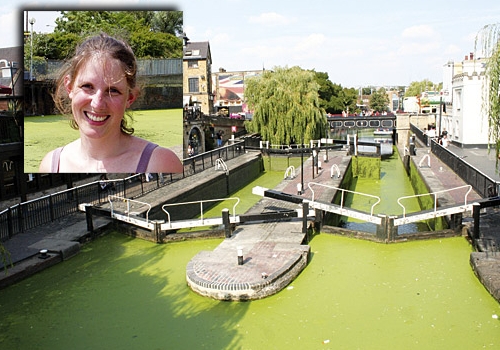Invasion of green menace threatens Regent's Canal’s wildlife

Daily clean-up launched as duckweed spreads in summer heat
Published: August 4, 2011
by DAN CARRIER
IT has spread quickly, like a green blanket across Regent’s Canal, and now British Waterways is taking drastic action to rid Camden Lock of a summer menace.
Fast-growing duckweed has turned sections of the canal into a stodgy mass of rotting weed – threatening fish and waterbirds who have made the increasingly clean water their home.
British Waterways is now sending a “weedman” with a giant scoop out daily in a boat to battle with the explosion of tiny, clover-like plants.
British Waterways ecologist Leela O’Dea says duckweed, a plant native to Britain, has enjoyed almost perfect growing conditions this summer. But with litter getting caught up in the weed and wildlife beginning to suffer, it is time for drastic action.
She said: “This year it has been very warm consistently and the canal provides the perfect conditions: it is nutrient rich and slow flowing.”
Duckweed grows quickly by splitting its leaves in two. Over the past week, duckweed by the Lock has covered a stretch from the Pirate Castle in Oval Road to Kentish Town Road bridge – despite a clean-up operation and canal boats helping to break it up as they chug through.
Ms O’Dea said: “We are keeping a close eye on the situation and have someone working permanently to remove it, but it is a pretty impossible job to stop it getting to epic proportions. It can become a problem if it becomes two to three inches thick.
“It grows incredibly quickly, given the right conditions. It can reduce oxygen levels if there is too much of it.” Fears that the warm weather would lead to a toxic algae bloom are unfounded, said Ms O’Dea.
Canal water quality is acceptable. Although not good enough to swim in or drink, the water is healthy for wildlife and at its best for many years.
The Georgians and Victorians who built the canal network used it as drain, with factories tipping all sorts of effluent into the water. Now, the canals work as extra storm drains if there is a downpour, which means petrol and oil can sometimes find its way into the water – but not to dangerous levels.
The numbers of dragonflies and damselflies show the Regent’s Canal water is in good health. “They are particularly sensitive to pollution as they have long life cycles, spending two to three years underwater as nymphs,” Ms O’Dea said.
“This means they are good indicators of water quality and there are plenty to be found in and around Camden Town.”
In recent years, British Waterways has laid reed beds at King’s Cross to help encourage invertebrates, a source of food for fish.




Comments
It's spread to Bethnal Green!
Submitted by Anonymous on Sat, 2011-08-20 16:28.Its all well and good that Camden have employed someone to remove the duckweed from Camden but it has also spread quite rapidly further down to Bethnal Green and beyond. Can you tell me if the clean up effort has also spread to Bethnal Green and beyond?
Also, is the anything that I or my neighbours can do to help curb the spread of the duckweed in and around my immediate area?
Thank you.
Post new comment